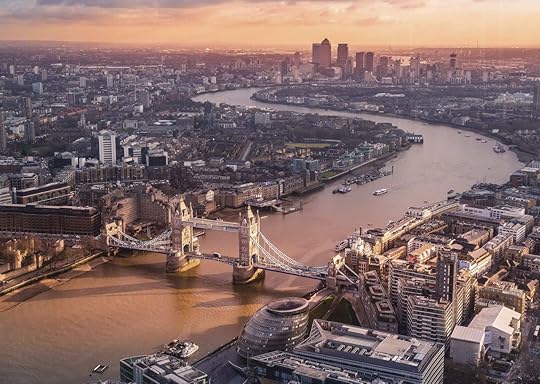Matador Network's Blog, page 971
November 20, 2019
Rare wildlife in Ecuador’s highlands

When we think of environmental diversity, the Galapagos Islands and the Amazon Rainforest may come to mind. Ecuador is home to those islands and a portion of that rainforest, yet there is much more to the country than that. This equatorial nation includes the northern end of the world’s second-highest mountain range, and its highlands are filled with remarkable plant and animal life found nowhere else on Earth.
In fact, Ecuador is home to more than 30 national parks and reserves, all in an area the size of Nevada — making it even more surprising that it isn’t widely recognized as the incredible eco-destination that it is. Among these natural areas are three astounding landscapes you’ve never heard of, all of which you can easily visit from the nation’s capital.
1. Angel Ecological Reserve — a rare tree evolved from sunflowers
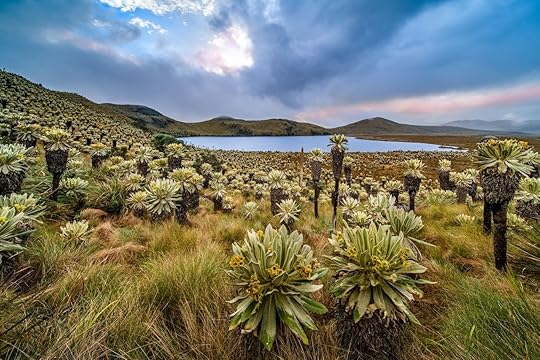
Photo: Vaclav Sebek/Shutterstock
Topping the list as one of the most unique landscapes, El Angel Ecological is a vast and remote hideaway pinched between Ibarra and the Colombian border. Regarded as a no man’s land by many, the sprawling 4,000 acres hide several rare tree species including the frailejones and the polylepis, which grow in the high-altitude grasslands.
The frailejones is a mysterious evolution of the sunflower, coated in opalescent fuzz and towering as many as 20 feet in the sky. Thriving in the sometimes frigid and thin high-altitude air, the plant is considered endangered, only known to exist here and in the bordering Colombian territory. Ironically, it’s also a leading species in water sustainability. It has the important ability to absorb atmospheric moisture into its spongy trunk, later dispersing it back into the soil through its roots. The action directly contributes to underground water supplies that eventually blossom into rivers and lakes.

Photo: Ecuadorpostales/Shutterstock
The furry frailejones share territory with the polylepis, lovingly referred to as the paper tree. This tiny tree resembles a gnarled shrub with peeling bark, and it’s closely related to both the rose bush and evergreen trees. Endemic to the tropical Andes, it has the uncanny ability to flourish far above the typical tree line at altitudes in excess of 16,000 feet, all while keeping its leaves intact year-round. The polylepis is best known for having a peeling bark that pulls off in thick layers like tissue paper. The tree is capable of producing or shedding numerous layers of bark in an effort to adapt to the fluctuating temperatures of its natural habitat.
Animals are also varied and abundant in the mysterious landscape, supported by vast water sources and an extended food chain. El Angel Ecological Reserve is home to some of the last wild alpaca herds, the paramo wolf, deer, rodents, and birds including the endangered Andean condor and the carunculated caracara, a bird that is both a scavenger and predator of small animals.
2. Cotopaxi National Park — avenue of the volcanoes

Photo: SL-Photography/Shutterstock
Unless you’re a mountain-climbing aficionado, it’s likely that Cotopaxi National Park hasn’t landed on your bucket list… yet. Its claim to fame is the namesake Cotopaxi Volcano, sometimes overshadowed by the neighboring Chimborazo Volcano. But simply calling it the second-highest volcano in Ecuador is an epic understatement. For the Cotopaxi Volcano is still one of the highest volcanoes on Mother Earth — and it’s been active for nearly 500 years.
Part of the Andes Mountain range and the notorious Ring of Fire, the Cotopaxi Volcano scratches the sky at 19,347 feet. Although the snow-capped volcano is the obvious shining star of the Cotopaxi National Park, the park offers so much more. At the base of Cotopaxi lies a sprawling ecological reserve spanning nearly 130 square miles, which includes several additional volcanoes within an offroad tourism route known as the Avenue of the Volcanoes.

Photo: Ammit Jack/Shutterstock
Even so, the surrounding terrain reveals a stark contrast of peaks and valleys. Rather than a mountainous strip of cones and craters, the volcanoes are peculiarly surrounded by sweeping panoramic highlands bursting with a fascinating array of flora and fauna. The so-called sub-Andean plains lend themselves to several humid vegetation zones including paramo, or a high-altitude tropical zone; evergreen forests; Andean tundra; and moorlands, or high-altitude grasslands. The cold, wet atmosphere provides ideal living conditions for more than 200 species of grass, plants, moss, and lichens.
The pristine and varied landscapes play host to a surging ecosystem for countless animal species, including marsupials, red brocket and white-tailed deer, pumas, Andean wolves, the rare spectacled bear, more than a dozen hummingbird species, numerous birds, amphibians, and more.
3. Antisana Ecological Reserve — glaciers, hot springs, and a lot of life
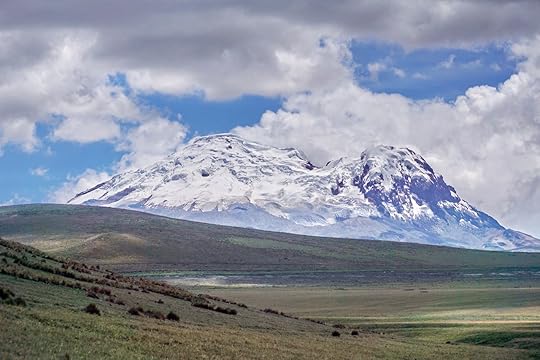
Photo: Angela N Perryman/Shutterstock
Stemming from an area regarded as the “Orient of the Andes,” the Antisana Ecological Reserve claims a whopping 300,000 acres of territory in the Ecuadorian Andes. Similar to the Cotopaxi National Park, the Antisana Ecological Reserve takes its name from the primary volcano within its reach, the Antisana Volcano.
Although majestic and mysterious, the 800,000-year-old Antisana Volcano is quiet and subdued, lending itself as a snowy silhouette while letting the astounding life veins below take center stage. Indeed, the abounding flora and fauna are so precious that they inspired the very reserve around them.

Photo: Angela N Perryman/Shutterstock
Bound by landscapes riddled with glaciers and hot springs, dense forests, gorges, lakes, rivers, waterfalls, and mountains, the living beings who thrive here are subjected to some of the harshest living conditions imaginable. Yet despite cold, dry temperatures, high winds, and low oxygens levels, the Antisana Ecological Reserve cradles an astounding six dozen mammal species, nearly as many amphibian and reptile species, and over 400 unique bird species.
The most notable creatures are as varied as the landscapes and include the mountain tapir; white-fronted spider monkey; Andean condor; black-faced ibis; northern pudu, or world’s smallest deer; the spectacled bear; rare Andean cats; and an endangered mountain toad.
Visiting Ecuador’s national parks and reserves

Photo: SantizU/Shutterstock
Each of these national parks and reserves in Ecuador can be easily visited with trips from the capital city of Quito. Coming in as the most remote option, El Angel Ecological Reserve is located approximately five hours driving northeast of Quito with a halfway point in Ibarra. Visitors can enter the park either independently or as part of tour groups. Hiking, biking, and camping are permitted although there are no modern facilities. The park is open year-round but is best appreciated in the dry season from May to November.
Cotopaxi National Park is an easy day trip option from Quito, located just over an hour’s drive south of the city limits. Entrance into the park is closely regulated and requires all visitors to check-in with a government-issued ID at the ranger stations. While there is no cost to enter, access may vary in accordance with volcanic activity. Guided tours to the park are popular but not required. For mountain climbers and extreme hikers, there is a mountain refuge. Otherwise, camping, biking, climbing, hiking, and off-road vehicles are permitted in designated areas. The park is open year-round but can be closed due to poor road conditions, snow, and volcanic activity. The best time to visit is from June to October.
The Antisana Ecological Reserve can be found approximately 90 minutes driving southeast of Quito, just beyond the site of the Papallacta hot springs. Hiking, boating, fishing, camping, and horseback riding are allowed within designated areas of the reserve. Visitors are welcomed independently and through arranged tours. Minimal admission fees may exist but are not always heavily enforced. Weather conditions are fairly stable year-round with heavier fog likely between December and April. 

More like this: Ecuador packs the most adventure into a small space better than anywhere else in South America
The post Ecuador’s highlands are full of rare plants and animals you need to see appeared first on Matador Network.

Whales back from near extinction

It’s time to celebrate for western South Atlantic (WSA) humpback whales. After being on the edge of extinction because of intensive whaling practices, the species is now projected to return to nearly 99 percent of its pre-exploitation numbers by 2030, according to a study published in Royal Society Open Science.
Between the late 1700s and the mid-1900s, it is estimated that 300,000 humpback whales were killed. The study explains that the population of WSA humpback whales went from almost 27,000 pre-whaling to just 440 by 1958. Since then, however, WSA humpbacks have been making a comeback, mostly due to the moratorium on commercial whale hunting imposed by the International Whaling Commission (IWC) in 1986.
Today, nearly 25,000 WSA humpbacks are swimming freely, and there is a high probability that the total population will recover in 10 years.
While the conservation story of the WSA humpback whales is a resounding success and proves the importance of legal protection and conservation projects, these encouraging findings don’t mean the species is completely safe. Modern-day threats linked to climate change and ocean pollution present extreme risks for the marine mammals. 

More like this: In search of whales
The post South Atlantic humpback whales are back from the edge of extinction appeared first on Matador Network.

Best neighborhoods in Tokyo

Tokyo is not an easy place to define. Even “metropolis” sells it a little short. In reality, it’s a megalopolis; a densely packed and towering urban sprawl home to over 38 million people. Yet in spite of Tokyo’s sheer size and scale, the same neighborhoods draw in tourists like the inexorable forces of gravity. While marveling at Shibuya Crossing or exploring the pop-culture towers of Akihabara are worthwhile endeavors, there’s a lot more to the Japanese capital. Venturing into less charted territory you’ll find plenty of equally great neighborhoods which have managed to slip under the radar of Tokyo’s tourism sphere. Here are five of the best.
1. Jimbocho

Photo: MMpai/Shutterstock
Jimbocho is Tokyo’s town for bibliophiles. The neighborhood, home to the prestigious halls of Meiji University, is famed in local circles for its dedication to preserving the printed word. Pedestrianized streets shooting off from the main thoroughfare, Yasukuni-dori, are lined from top to bottom with old-school book stores (as much as 200 according to some folks), some of which have been in business since the late 19th century. The oldest, Takayama Honten, was established in 1875 and specializes in books on kyogen and noh theater.
Naturally, a lot of the stores are filled with old Japanese academic tomes that are dog-eared, falling apart at the seams, and weighing down the rickety shelves. But while certainly outnumbered, English books have far from dissolved into anonymity.
Local recommendations for Jimbocho
Kitazawa Shoten is a wonderful establishment in which to peruse the shelves. It’s an antiquarian bookstore selling a host of second-hand books — mostly classic English literature — in its ornate and lofty hall. Accompanying these are rare first editions which you can read under lamplight at varnished, mahogany tables. @Wonder, a graphic novel and magazine store, operates at the opposite end of the spectrum, peddling cheap Marvel, DC, and obscure retro superhero comics from the ‘70s and ‘80s.
The best time of year to visit Jimbocho is during the 10-day Kanda Used Book Festival in late October/early November, where all the shops spill out onto the streets, selling their bountiful wares for reduced prices.
2. Kita-Senju
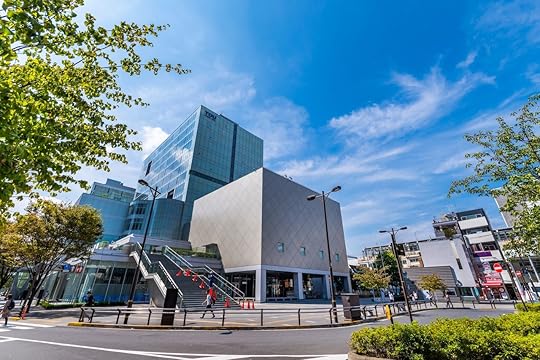
Photo: picture cells/Shutterstock
Kita-Senju, a funky and increasingly student-centric district, lies in the otherwise quiet northern Tokyo ward of Adachi. Kita-Senju’s crown jewels are the yokocho (alleyways) snaking away from the train station’s west and east exits. Along the yokocho you will find ramshackle bars fit to seat no more than 10 patrons, sitting shoulder-to-shoulder with izakayas (traditional Japanese pubs) specializing in local finger food and sake. Squeezed in among them are ramen and grilled meat shops billowing steamy, umami aromas into the cramped lantern-lit walkways. It’s similar to Shinjuku’s famous Golden Gai area, but with better food and next to no tourists.
Local recommendations for Kita-Senju
Pari Pari is a classic izakaya serving a range of local dishes and some lovely sake (hot or cold). The restaurant’s name is an onomatopoeic word for crispy, and the crispy-skin chicken is its pièce de résistance. Alternatively, Agalico, a Japanese tapas restaurant with a Mediterranean twist, has delicious sharing plates and a rotating craft beer menu to help you slug it all down.
3. Shimokitazawa
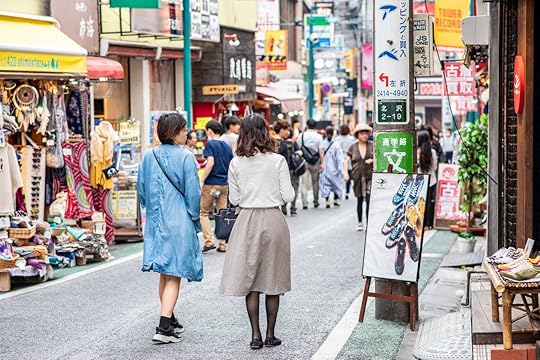
Photo: Page Light Studios/Shutterstock
Shimokitazawa, a bohemian neighborhood lying west of Shibuya, is in the thrall of a youthful renaissance, imbuing it with a renewed sense of energy. This new hipster vibe has caused Shimokitazawa to draw frequent parallels with Williamsburg, Brooklyn. And much like Williamsburg, the arts are fundamental to what makes “Shimokita” tick. You can watch live Japanese performing arts at the Honda Theater, catch some stand-up comedy (in English) at Good Heavens, enjoy cheap music gigs at Garage, or check out contemporary art-themed events and culinary markets at Shimokitazawa Cage.
Paradoxically in the 21st century, when you have a neighborhood populated by youths and quirky sub-cultures, themes of retro nostalgia seem to spring forth just as readily. Shimokitazawa is no different. The colorful walkways around the station are lined with vintage clothing stores and vinyl LP shops; if you want to buy records or “wavy” shirts from the days of yesteryear, there is no better place in Tokyo.
Local recommendations for Shimokitazawa
Flash Disc Ranch, immediately recognizable due to its doorway shaped like the gaping mouth of an acid-tripped monster, is one of the finest places to sift through a hefty and dusty vinyl record stock. If you’re on the hunt for retro garments however, the chain of MICMO stores in the area are not a bad place to start. Any coffee-lover worth their salt won’t be able to walk past the doors of Moldive without subconsciously drifting in for a cup of fresh roast.
4. Ebisu

Photo: DymFilms/Shutterstock
Due to its large expat community, Ebisu is very much cosmopolitan Tokyo but that’s not necessarily to its detriment. At only a stop from Shibuya on the Yamanote Line, it’s right in the heart of Tokyo’s downtown. Ebisu marries the modernity of Western influences in Japan with traditional throwbacks to the old neighborhood which sprung up in the 1920s. It was named after the eponymous Yebisu beer distillery (now in Sapporo) which had been brewing in the area since the late 1800s.
Local recommendations for Ebisu
Yebisu Garden Place epitomizes the neighborhood’s metamorphosis. The striking glass-domed complex features an eclectic mix of European and Japanese eateries, alongside a fine-dining Joel Robuchon chateau restaurant. Next door is a tall tower with bars and observation decks displaying panoramic views of Tokyo’s concrete sprawl, marching toward the horizon — on a clear day you can catch sight of Mount Fuji standing sentinel over the capital. You can also watch independent cinema in the small Yebisu Garden theater, or check out one of the many festivals held in the outdoor event space, including a Yebisu beer Oktoberfest.
Conversely, Ebisu Yokocho is as Japanese as they come: a steamy hallway of open kitchens and bars with low seats and tables haphazardly scattered around the floor. If you want to hop from spot to spot sampling the different kinds of cuisine, by all means do so as you won’t be disappointed. Bear in mind, most places will have a small table charge and on the weekends and evenings, salarymen pile in en masse — so it’ll be difficult to get seated in larger groups.
5. Kichijoji
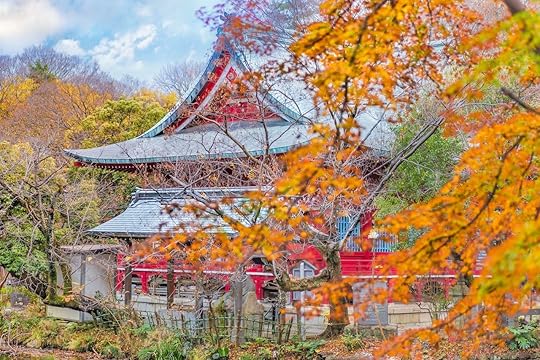
Photo: kuremo/Shutterstock
Kichijoji lies in the surprisingly leafy western suburbs of Tokyo and is home to what is certainly one of the finest inner-city green spaces in Japan: Inokashira Park. The park’s centerpiece is a large pond of the deepest green, covered in dense splotches of algal bloom. The paths skirting its perimeter are flanked by overhanging maple and cherry trees and a large outdoor stage and seating area which groups of musicians often take to for practice sessions in the hotter months of the year. The mysterious Benzaiten shrine, built in honor of a vengeful Buddhist goddess, is erected on a boardwalk near the pond’s western banks, while patrons flock to candle-lit restaurants looking out on the pond as dusk settles. It’s a seriously atmospheric setting and never feels as crowded as the over-populated parks in Ueno and Shinjuku.
Local recommendations for Kichijoji
Pepa Café Forest, a Thai restaurant in Inokashira Park, is a great stop-off point for pad Thai, hot curries, and cold Singha beers. Or if you head to the other side of Kichijoji Station, you’ll find the acclaimed Harmonica Alley. This matrix of covered alleyways used to be part of an old flea market. Now they’re home to food stalls and cheap restaurants specializing in Japanese soul food: sizzling yakitori skewers, regional ramen, gyoza dumplings, and taiyaki, a fish-shaped pastry with filling. 

More like this: The ultimate travel guide to Tokyo, Japan: Best things to see and do
The post 5 of the best under-the-radar neighborhoods in Tokyo appeared first on Matador Network.

Credit for hiking Appalachian Trail

If sitting on a chair for four years to earn a college degree makes you antsy, know that there are options out there to get you out of the classroom and moving. Emory & Henry College in Virginia is offering any college students around the world the chance to earn college credit while hiking the famous Appalachian Trail. Stretching 2,190 miles through 14 states, hiking the trail is no easy feat, but that’s exactly what makes conquering it worthy of college credit.

Photo: Appalachian Trail
The initiative is part of the college’s outdoor program called “Semester-A-Trail.” Students who enroll complete a wilderness first aid course, as well as other outdoors training with Emory & Henry College before they set off on the trail. They are provided with backpacking gear, footwear, and an on-trail hiking budget.
You don’t have to be an outdoors student to participate, however; all you need is an academic goal that will be achieved thanks to the hike. For example, Sadie Burton, a creative communications major at Emory & Henry, took on the challenge with the goal to film a documentary and put together a photography art show. She hiked 400 miles of the trail.
And don’t worry — even if you’re not currently a student at Emory & Henry College, you’re welcome to transfer there for a semester while earning your trail credits. Tilghman Moyer, a transfer phenology student from Temple University, completed the thru-hike in five months and studied plant and animal life cycles along the way in collaboration with the Appalachian Trail Conservancy.
To learn more about the program, check out Emory & Henry’s website and watch the video below.

More like this: 7 insane hikes with epic views that are worth your blood, sweat, and tears
The post This college will give you class credit for hiking the Appalachian Trail appeared first on Matador Network.

Britain: Choose Your Own Adventure
‘Game of Thrones’ luxury cruise

If you’re still in denial about Game of Thrones ending, there’s a way to cling onto the series a little bit longer. A Game of Thrones cruise experience is launching in 2021 thanks to Dalmatian Travel & Events. The Cruise of Thrones will bring fans to filming locations across Europe, with guests able to choose from several itineraries depending upon their trip preferences. Two itineraries are eight-day excursions sailing either toward the north (Iceland, Ireland, and Northern Ireland) or the south (Spain, Malta, and Croatia). You can also book both sailings back to back for an epic 16-day trip where you get to see it all.
Some highlights include visiting the filming locations of the Tower of Joy and the Citadel in Spain; King’s Landing in Malta; the Fist of the First Men in Iceland; and the Wall, Castle Black, and Winterfell in Ireland.
When you’re not visiting these iconic locations, you’ll be relaxing on a ship decorated to resemble the world of GoT. According to the cruise’s website, dining rooms will “transform into the feasting halls of Winterfell. The Solarium becomes the Water Gardens of Dorne. The walk to your stateroom is through the Great Pyramid of Mereen.”
There’ll also be events specifically designed for hardcore fans, like storytelling, a cosplay parade, scavenger hunt, podcasts, lectures, and panel discussions. And with featured guests promised, the GoT vibe certainly won’t be lost while onboard.
Cruise packages begin at $5,130 per person, with a deposit of $1,000 due at the time of reservation. The cruise is planned to set sail in September 2021. Visit the website for a chance to win this cruise free for two — a $10,000 value. 

More like this: 23 real-life settings you can visit from Game of Thrones
The post This epic ‘Game of Thrones’ luxury cruise will take you to the series’ emblematic filming locations appeared first on Matador Network.

What do Icelandic names mean

Cultural conventions for naming newborn babies vary around the world and reveal a great deal about social priorities and history.
The Navajo of the US Southwest use their first name and their two clan names when introducing themselves, and they relay their mother’s clan line before the father’s. This tradition shows the tribe’s matriarchal focus. In Spain and most of its former colonies, such as Mexico, babies are given each of their parents’ surnames but the order tends to reflect the patriarchy, with the father’s last name almost always coming before the mother’s.
In Iceland, traditional infant-naming conventions are so integral to the culture that they’re protected by law. Icelanders’ long-standing tradition of giving a newborn its father’s first name for a surname is unique. It’s confusing for outsiders, and sometimes frustrating for the Icelanders themselves, but it serves a major function: It keeps Icelandic tradition alive.
When a baby is born, it will almost always inherit its father’s first name, or patronym. The suffix -son (“son of”) is added on if the child is a boy. For example, if a baby’s father’s first name is Aron, arguably the most common Icelandic boy’s name, his last name would be Aronsson.
If the baby is a girl, the suffix -dóttir (“daughter of”) is tacked on to father’s name (often with an “ar” or an “s” before the suffix for pronunciation). The world-famous Icelander singer Björk Guðmundsdóttir’s father was named Guðmund.
If the mother’s first name is the also-popular Katrín, there’s a chance the child’s surname could be Katrínardottir. Using the matronym is rare and usually indicates a falling out between the parents. That’s not always the case, however. As of 1991, parents may choose which name comes first but it’s almost always the father’s.
As of 2019, Iceland passed a Gender Autonomy Act, and gendered naming conventions began to evolve to reflect a more inclusive era. Prior to this act, a girl could not have a traditionally masculine first name, or vice versa. Now parents can select from all registered names.
If an individual is officially registered with the government as non-binary, or gender “X,” they may change their surname suffix to -bur, which means “child of.” A person born as Selma Egilsdóttir can now be Selma Egilsbur.

Photo: Blue Planet Studio/Shutterstock
This specific newborn naming convention used to occur throughout much of the Nordic region. Today, though, only Iceland retains it. Those who wish to adopt original family surnames need to obtain express permission from the strict Icelandic Naming Commission (Mannanafnaskrá).
Founded in 1991, the Icelandic Naming Commission must approve any name-related challenges or change requests, including first, middle, and last names. The commission also regulates what new names can be registered into the 1,200-year-old language, keeping a tight grip on heritage.
The goal of all these regulations is to ensure the continuance of Icelandic. All names must carry on the alphabet, grammar, declination, suffixes, and pronunciation integral to the language. Also, a name must “not cause the bearer embarrassment,” according to the commission, which also rules that no one can have more than three names in addition to their surname (but only one can be a middle name). There are a total of just over 1,700 approved boys’ names and about 1,850 girls’ names.
If a first-name adoption or change is rejected, the commission often defaults to renaming the person “Drengur” (boy) or “Stúlka” (girl). According to Icelandic law, parents have six months to name their child. But in the 2014 case of Harriett and Duncan Cardew, a sister and brother duo whose names were not recognized by the Icelandic National Registry, the two children had passports with the “Stúlka” and “Drengur” placeholders until they were 10 and 12 years of age.
Keeping a language alive can be tough in places with populations as low as Iceland’s — a nation with only about 360,000 citizens and a fertility rate of 1.8 births per woman, waning since the 1960s. But even in such a small country, when no new surnames can emerge, it can be difficult to tell who’s who. The nation’s phone books are arranged by people’s first names and note the individual’s occupation to ease the confusion. Generally, people only refer to one another by their first names anyway, but in the case of a plurality of Björks at a party, middle names are used as well.
The naming convention can be a hassle in hospitals and airports, especially when Icelanders move abroad, where, in almost all cases, children are expected to inherit a unified family surname. Iceland doesn’t have family surnames, and upon marriage, neither partner takes the other’s last name.
Problems can also arise when parents who have roots in another country want to give their Iceland-born child a foreign name that would reflect their origins. In that case, however, both parents must be nationals of another country than Iceland to be allowed to pick from outside of the list of approved names (and they must also give the child an Icelandic one from the list).
Difficult and regulated as it might be, there is something to be said for the maintenance of language and tradition — and for the fact that Icelandic kids are protected from getting a silly name like Blanket, Blue Ivy, North, or Apple. 

More like this: How to find a job and move to Iceland
The post appeared first on Matador Network.

November 19, 2019
LGBTQ travel in Brighton, England
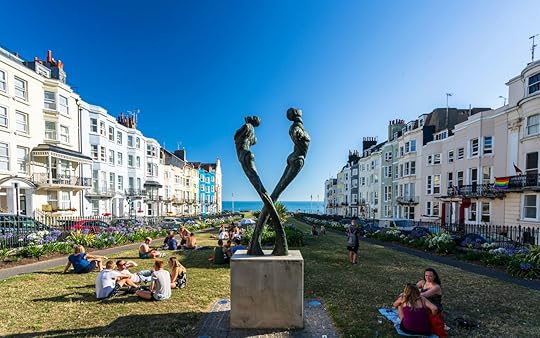
The seaside city of Brighton, located between the rolling hills of Sussex, is one of the UK’s premier LGBTQ destinations. Brighton’s queer history dates all the way back to the early 19th century when soldiers were garrisoned in the city during the Napoleonic wars. By the end of the second World War, several gay pubs and clubs had emerged, and Brighton had become a hub for gay men and lesbians who were serving in the forces. Within an hour’s train ride of London, Brighton also enticed those from the capital who wanted to escape the confines of closeted lives.
The first Gay Pride parade took place in 1973, consisting of a small contingent of marchers, very much in contrast to the 200,000 revelers who converge on the city these days for one of the largest Pride festivals in the country. Since 2013, Trans Pride has also hit the streets of Brighton. The event gives trans, intersex, and gender-fluid folk the opportunity to be visible and have a party of their own. The parade makes its way along the seafront to Brunswick Square where there are stalls, speakers, and performers.
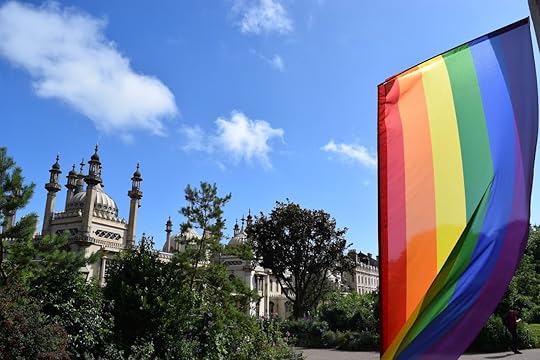
Photo: Laura Cody/Shutterstock
The city’s LGBTQ scene continues to thrive, but there is more to Brighton than its vibrant clubs, bars, and pubs. The free-spirited city has an impressive live music scene, an abundance of funky cafes, and oodles of cool independent stores. For traditional seaside fun and frolics, there’s the pebble beach lined with restaurants and bars and the iconic Victorian Palace Pier with an amusement arcade and funfair rides.
Brighton’s diversity is what makes it such an appealing destination for LGBTQ travelers, non-conformists, or simply anyone who has an appreciation for the quirky side of life. As much as 15 percent of Brighton’s population identifies as LGBTQ, and evidence of this can be seen throughout the city. Here’s everything you need to know about visiting Brighton as an LGBTQ traveler.
The main LGBTQ neighborhood
Kemptown
Kemptown, an area just east of the Palace Pier, is the nucleus of queer life in this seaside metropolis, and you can’t walk further than a block without a reminder that you are in the gay heart of Brighton. The majority of the action takes place a block either side of St. James’s Street in Kemptown. Rainbow flags flutter from the bars, clubs, and restaurants, and it’s not uncommon to see a drag queen smoking cigarettes outside one of the many LGBTQ establishments.
Kemptown is also where the Pride party is held each year, which sees the whole area closed off to traffic for two days. Although most of the bars are in the same vicinity, making a bar crawl an easy stagger from one drinking hole to the next, there are LGBTQ venues situated throughout the city. Most of the pubs in Brighton are LGBTQ-friendly, and the general vibe is all-encompassing.
Beaches and Landmarks
AIDS Memorial Sculpture
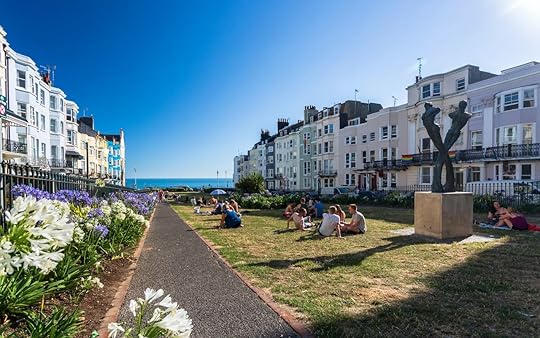
Photo: Toms Auzins/Shutterstock
Situated in New Steine Gardens, Kemp Town, Brighton’s AIDS Memorial Sculpture showcases two bronze figures, one male, one non-gender. The art casts a shadow in the shape of the ribbon, designed for the support of international HIV and AIDS awareness. The memorial was unveiled by David Furnish in 2009. The garden which homes the statue is a peaceful spot to relax and, weather permitting, a perfect place for a picnic.
Black Rock
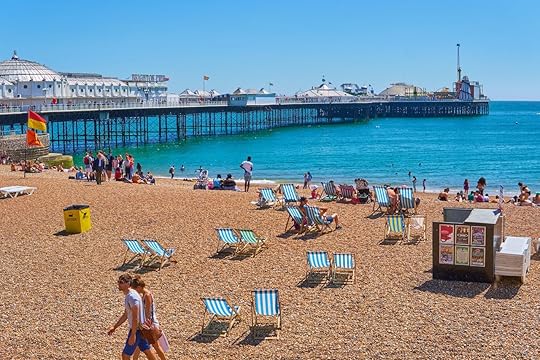
Photo: Michaelasbest/Shutterstock
Although not exclusively LGBTQ, the naturist beach at Black Rock, adjacent to the marina, is the most favored beach hangout, particularly among gay men. Dukes Mound, the area behind the beach, is a popular cruising spot.
The Brighton Sauna
The Brighton Sauna is the largest sauna in the southeast of England, and among the facilities is a playroom, hot tub, and sling room. Events include Naked Days and Fetish Nights, and the clientele is diverse in age and body type.
Bars, clubs and restaurants
Club Revenge

Photo: Revenge Brighton/Facebook
Spread over three floors, Revenge is Brighton’s longest established club and is still the city’s premier dance spot. The playlist tends to consist of gay anthems and pop tunes. Both the sound system and lighting are impressive, and there’s a roof terrace with a bird’s-eye view of the pier and seafront. Although it’s officially an LGBTQ venue, and twinkies make up the majority of the punters, the venue also tends to attract gaggles of hen parties and straight kids. Just around the corner, their R-Bar is a great place to take advantage of some extremely attractive drink deals.
Where: 32 Old Steine, Brighton, BN1 IEL
Velvet Jacks
This girl bar is located on Brighton’s main shopping through-fare and is run by wife-and-wife team Jackie and Eve. It’s a cozy bar with a friendly community vibe, and due to its size, it’s one of those places where it’s easy to get talking to people and make new friends. Regular quiz nights and occasional live music events are held here, as well.
Where: 50 Norfolk Square, Brighton, BN1 2PA
Charles Street Tap

Photo: Charles Street Tap/Facebook
One of the larger bars in Kemptown, Charles Street Tap is open from 10:00 AM to the early hours. There’s always something going on, whether it’s quiz nights, DJs, cabaret, or drag. A good value food menu is available throughout the day, and there are regular drinks deals. The bar attracts a slightly older crowd and is located on the seafront.
Where: 8 Marine Parade, Brighton, BN2 1TA
The Bulldog
Operating since 1979, The Bulldog is a stalwart of the local scene. The bar is known for its long hours, and stragglers can often be seen loitering outside at 7:00 AM. The Bulldog serves up cheap drinks, karaoke, and drag acts, and it remains a favorite with gay men despite its basic interior and sticky floors.
Where: 31 St. James’s Street, Brighton, BN2 1RF
Bar Broadway

Photo: Bar Broadway/Facebook
Hidden away on a backstreet opposite the pier, Bar Broadway is a fun night out for anyone who loves a show tune. Back-to-back videos feature songs from everything from Cabaret to Les Misérables, and there are regular cabarets. It’s the perfect bar for an old-fashioned sing-along with a bunch of friends.
Where: 10 Steine Street, Brighton, BN2 ITE
The Camelford Arms
This is a friendly and traditional-style boozer with a community vibe. A beautifully lit, Moroccan-style garden has heating for chilly days and nights. The menu consists of quality pub grub — the Sunday roasts are a legendary Kemptown treat. Everyone is welcome, including dogs.
Where: 30-31 Camelford Street, Brighton, BN2 1TQ
Marlborough Pub and Theatre

Photo: Marlborough Pub & Theatre/Facebook
The Marlborough is one of Brighton’s oldest LGBTQ pubs, and despite its rough-around-the-edges interior, it’s a friendly and inclusive space. Downstairs, a 60-seater theater has a somewhat alternative program of weird and wonderful events, all with a distinctly queer take.
Where: 4 Princes Street, Brighton, BN2 1RD
Events
Pride

Photo: Marius_Comanescu/Shutterstock
Brighton Pride has grown larger by the year and attracts revelers from all over the country and further afield. A flamboyant parade winds its way from the seafront to Preston Park for an all-day party on the first Saturday of August each year. In recent years, pop icons such as Kylie Minogue, Britney Spears, and The Pet Shop Boys have headlined. The action then shifts to Kemptown for a massive street party that lasts for the remainder of the weekend.
Accommodations
In Kemptown much of the accommodation is gay-run, and pretty much everywhere is LGBTQ friendly. There is an abundance of B&Bs to choose from in the area, all within a few steps of the bars.
Brightonwave Hotel

Photo: BrightonWave GuestHouse/Facebook
This contemporary B&B is right at the core of the gay village. A grade-two-listed Victorian building, the rooms are stylish and comfortable. The hosts, Richard and Simon, are hospitable and helpful. Apparently, the breakfast is outstanding — the perfect way to kickstart the day or perhaps cure that hangover.
Where: 10 Madeira Place, Brighton, BN2 1TN
Legends
Not only is Legends the largest LGBTQ hotel in Brighton, but it is also a bar and club. Located on the seafront, it has a sunny terrace that’s an ideal place to hang out and people watch or enjoy the sea views. The bar serves food, and evening entertainment includes drag acts and cabaret. A range of DJs play disco, funk, and pop at the Basement Bar. The rooms are modern, good value, and rates are according to room size.
Where: 31-34 Marine Parade, Brighton, BN2 1TR
LGBTQ Tours
Piers and Queers
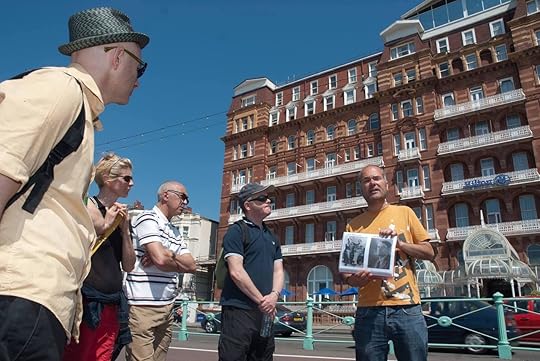
Photo: Only in Brighton/Piers and Queers Fringe Tours/Facebook
Piers and Queers is a walking tour that traces 200 years of local LGBTQ history. The tour provides nuggets of fascinating facts about famous figures from the LGBTQ community and stories of Brighton’s dandies and dykes. It also gives an insight into the activism that has taken place in the city and a look at how Kemptown has grown to become one of the liveliest LBGTQ communities in the country. 

More like this: The 10 most LGBTQ-friendly countries in Europe
The post The ultimate LGBTQ guide to Brighton, England’s queer capital appeared first on Matador Network.

Baku, Azerbaijan's best architecture
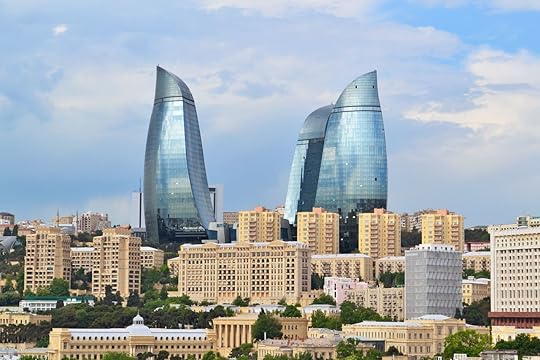
Bordered by Georgia, Armenia, Russia, Iran, and the Caspian Sea is Azerbaijan, a country most people can’t find on a map, nevermind know anything about its architectural styles. And because it is located in South Caucasus, a region of the world that incorrectly conjures little more than drab Soviet cities, nobody expects Baku, Azerbaijan’s capital city, to have an exciting skyline that could rival the likes of Beijing, Ryad, and London’s.
Baku’s electric urban landscape started with its first oil boom at the end of the 19th century, which brought a large population of immigrants to the nation. Before then, the city was contained within 12th-century fortress walls — a part of the Azerbaijani capital that is still standing today. After the Bolsheviks took over in the early 1920s, the lavish residences of oil barons were replaced by structures that were better aligned with the socialist ideology. But when the country gained independence in 1991, a second oil boom transformed the city again, and Baku modernized and expanded towards the sky.
As a result of its tumultuous history, the capital of the former Soviet Republic combines pastel-colored neoclassical facades with shiny skyscrapers and remnants of its long-gone Zoroastrian tradition. If, on the one hand, the UNESCO-listed Maidan tower reflects the city’s pre-islamic past, on the other the glistening Flame Towers leave no doubt about the demise of the socialist utopia. Sure, the nostalgic can always take a train ride to see the magnificent metro stations built in the late ‘60s, but make sure you don’t spend too much time underground — there’s plenty of head-turning constructions above the surface. Here are six of the most intriguing modern pieces of architecture in Azerbaijan’s capital city.
1. The Heydar Aliyev Center
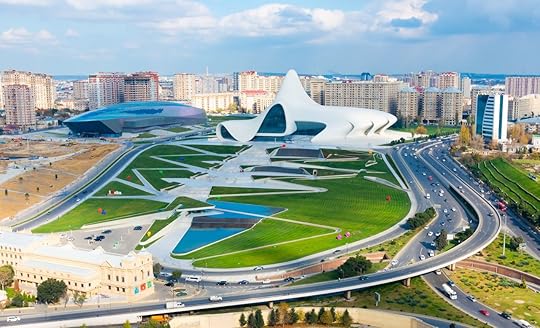
Photo: Nasimi Babaev/Shutterstock
Baku’s enormous cultural center is not just an unusual construction in an unexpected part of the world, it is an incredible architectural achievement that has been recognized internationally as a masterpiece of design. The Heydar Aliyev Center won the Design of the Year award in 2014, turning the building into one of Baku’s most photographed landmarks
Created by world-famous architect Zaha Hadid and completed in 2012, this structure, located on the Heydar Aliyev Boulevard on the way from the international airport to the historic city, is as modern and eye-catching as can be. From a distance, the unique structure’s walls appear like the undulating folds of soft fabric. The fluid shapes, glimmering glass walls, and bright white tiles stand out against a backdrop of stately Soviet-era housing blocks. The complex was built on an ample plaza featuring gardens and fountains.
Named after Azerbaijan’s former Soviet-era leader and president (1969-2013), the Heydar Aliyev Center is home to a museum, exhibition halls, offices, a cafetaria, conferences halls, meeting rooms, and a media center.
2. Flame Towers

Photo: Milosz Maslanka/Shutterstock
Positioned on a hill overlooking the Caspian Sea, Baku’s Flame Towers can be seen from pretty much anywhere in the city. Ranging between 36 and 39 stories high, the trio of iconic glass high rises was built to honor Azerbaijan’s ancient devotion to fire. Zoroastrianism, one of the oldest monotheistic religions in the world also known as “the cult of the fire,” was practiced in Azerbaijan before the advent of Islam, and many remnants of this ancient tradition — such as the Ateshgah Fire Temple or the Yanardag State Historical Cultural and Natural Reserve — can still be visited in the surroundings of the capital.
Erected by architectural firm HOK in 2013, the three Flame Towers stand strong against the winds of the Caspian Sea. Each of the three buildings serves a different function: The tallest tower houses 130 luxury apartments while the other two contain the five-star Fairmont hotel and office space.
2. Azerbaijan National Carpet Museum
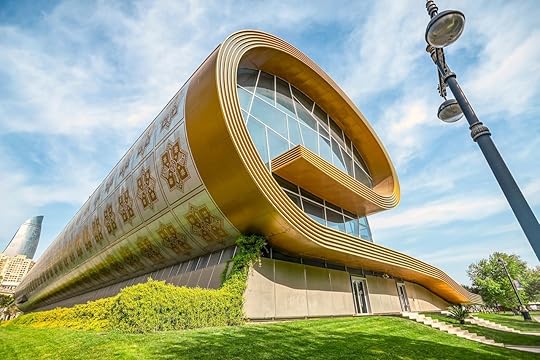
Photo: leshiy985/Shutterstock
While contemporary architecture may at times seem too conceptual for the untrained eye, this structure moves away from abstraction by providing a design that explicitly addresses the meaning behind the building. You really can’t get it wrong — Azerbaijan National Carpet Museum is built like a giant rolled-up rug.
The traditional art of carpet weaving is a significant part of Azerbaijani culture, and the Azerbaijan National Carpet Museum honors this tradition by displaying thousands of unique and precious examples of the carpet-weaving art from all over the country, from flat-woven carpets to pile carpets. The museum also covers other forms of Azerbaijani applied arts, such as metalwork, ceramics, and jewelery.
Designed by Austrian architects Franz Janz and Walter Mari with the support of UNESCO and completed in 2014, the Azerbaijan National Carpet Museum works has become a research, training, cultural, and educational center, as well as a tourist attraction.
3. Baku Crystal Hall

Photo: ArtNat/Shutterstock
After Baku was nominated to host the Eurovision Song Contest in 2012, it became necessary to build a venue that could hold thousands of arriving spectators. The Crystal Hall, located on a peninsula outside of the city center, was designed by the German firm GMP and the Swiss company Nussli, and it was erected in a record time of only eight months (just a month before the singing contest). Able to hold up to 25,000 people, the Crystal Hall functions as both a sports and concert arena.
The Crystal Hall is like no other building out there. Circular in shape, its exterior is entirely faceted like a crystal, and each of the flat faces is covered in LED lights, creating a futuristic light spectacle at night. During the Eurovision contest, the lights were used to show the colors of the flag of each contestant.
4. SOCAR Tower
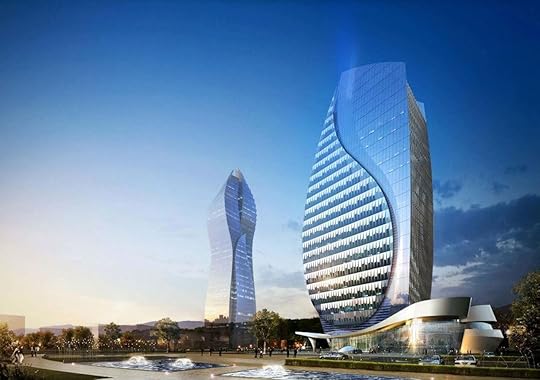
Photo: Heerim Architects & Planners Technical Design Studio/Facebook
The $230 million headquarters of the State Oil Company of the Azerbaijan Republic was completed in 2016 after a six-year-long process of construction by Heerim Architects, a Korea-based company. The twisted, high-tech glass building housing the SOCAR offices has come to dominate Baku’s skyline with its 685 feet in height. It is the tallest skyscraper in the whole of the Caucasus and probably the clearest expression of the immense focus on the oil and gas industry in the region.
5. Baku Convention Center

Photo: Baku Convention Center
A lesser-known example of Baku’s hyper-modern architecture is the Conference Center built in 2015. Again, this is the largest structure of this kind in the Caucasus, with 17 conference halls and a large auditorium capable of hosting 3,500 people. Located next door to the Heydar Aliyev Center, this futuristic and innovative complex contrasts the rounded forms of its neighbor with sharp angles and metallic colors. Designed by Austrian architecture firm Coop Himmelblau, the Baku Conference Center was created with more than just aesthetics in mind; it was built with building-integrated solar power and other low-energy consumption technology to reduce its environmental impact.
Beauty beyond the ultra-modern structures

Photo: Boris Stroujko/Shutterstock
Among the glass towers and eccentric structures are dozens of historic buildings that are worth checking out if you want a well-rounded perspective of the capital. Inside the UNESCO-protected Old City is the Shirvanshahs’ Palace Ensemble, built between the 12th and 15th centuries to house nine buildings, including the Dervish’s Mausoleum and the Palace mosque. Minutes away is the 97-foot tall Maidan tower, peeking out above the city walls. The origins of this structure are still uncertain, but some evidence suggests that it may have been built between the sixth and seventh centuries and originally served as a Zoroastrian temple, turning into an observatory and defensive watch tower over the course of its history.
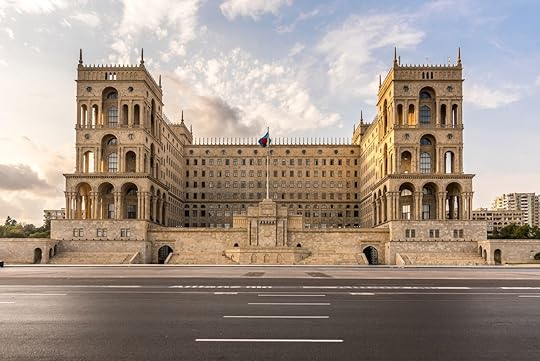
Photo: leszczem/Shutterstock
If imposing Soviet architecture is what you are looking for, head to the Government House (84 Uzeyir Hajibeyov) where the national flag has substituted a 36-foot-tall bronze statue of Lenin after independence. The 1972 Heydar Aliyev Palace, formerly known as Lenin Palace and not to be confused with Zaha Hadid’s recent Center, is a theater also worth checking out. 

More like this: 9 fascinating examples of Soviet-era architecture
The post Baku, Azerbaijan, has the most cutting-edge architecture in the world appeared first on Matador Network.

Lost AirPod prank San Francisco
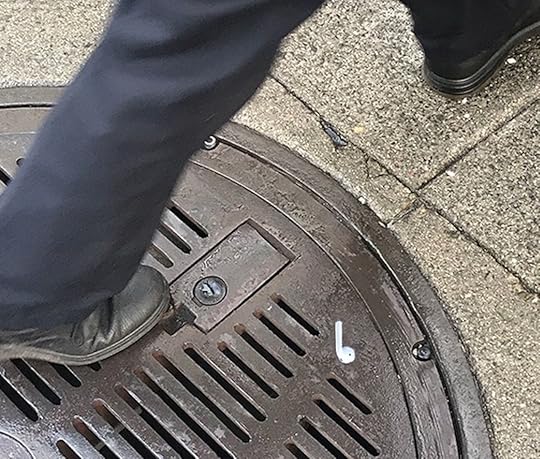
There’s no better feeling than finding a $100 bill on the sidewalk, and there’s no worse feeling than realizing that $100 bill is attached to a string, and someone hiding in the bushes is yanking your chain. Designer Pablo Rochat is taking that classic prank to the next level, by planting fake AirPods all around downtown San Francisco and observing people’s reactions as they try to pick them up — in vain.
According to Vice, Rochat was inspired when he noticed AirPods in the ears of everyone around him. To pull off the prank, Rochat created life-sized AirPod stickers that look exactly like the real thing.
I made life-size AirPod stickers and stuck them on the ground, all over the city
Matador Network's Blog
- Matador Network's profile
- 6 followers


